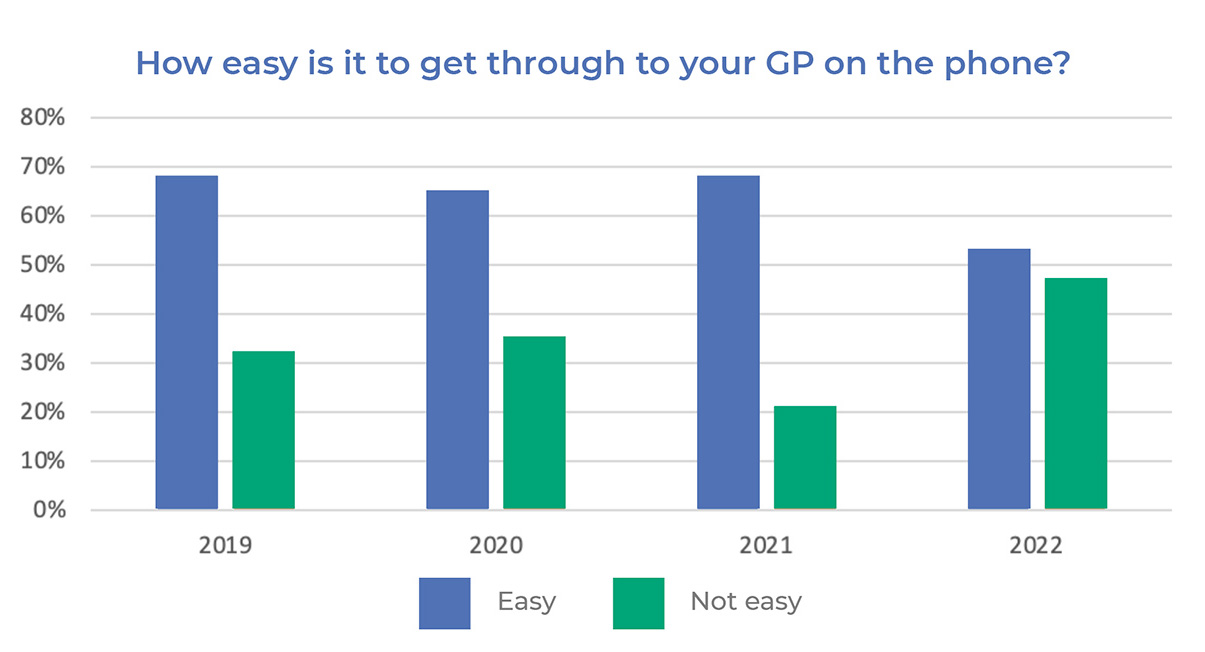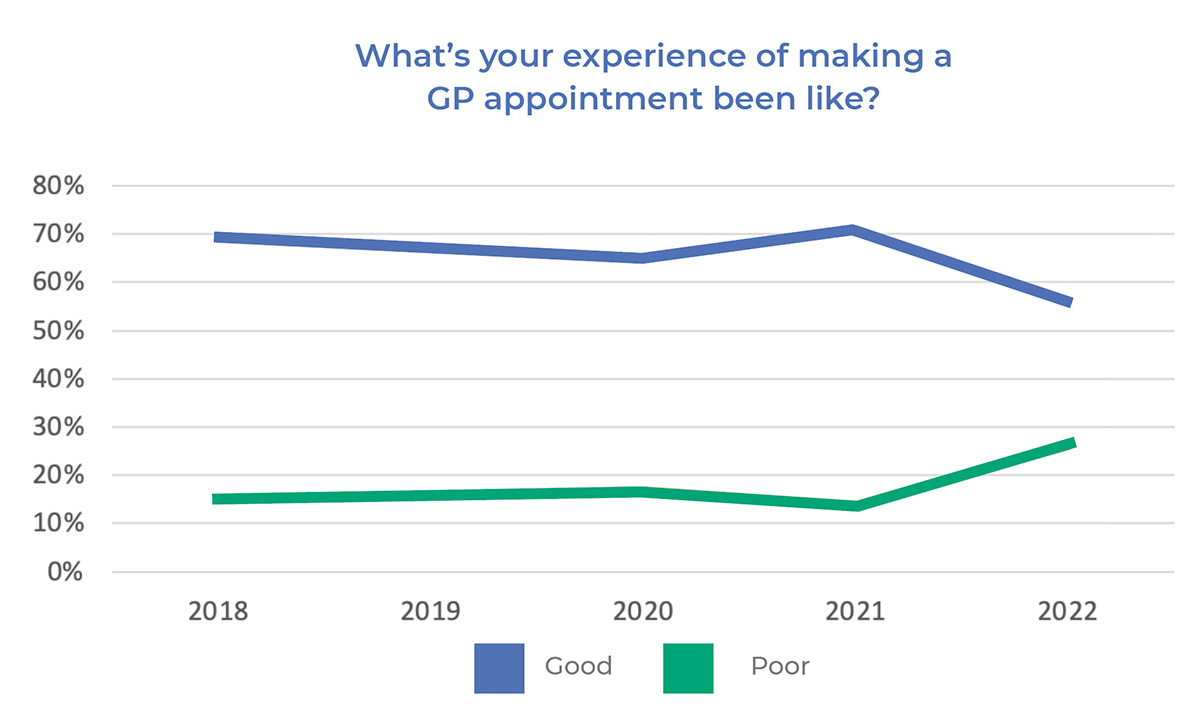In fact, the 2022 NHS England GP patient’s survey found that 15% of patients could not make an appointment when they last tried to make one – a sharp rise on the 10% reported in last year’s survey. When patients were offered an appointment only half (51.2%) were offered a time they wanted or sooner, another drop on previous years.
Across the board satisfaction with accessing GP services is dropping.
More than 1 in 4 (26%) rated the experience of making an appointment at their GP as poor. That’s up from just 14% in 2021 – and those trying to get through to their practice on the phone are particularly frustrated. Only 53% found it easy, compared to 68% who found it easy in 2021.
That means nearly half of people are finding it hard to get in contact – and the fear is people who should be being seen in a primary care setting are turning to doctor Google or just… giving up.

Graph source: www.england.nhs.uk
The result is a hidden backlog that’s yet to be added to the one we know about – which in October 2022 consisted of more than 7 million people currently waiting for treatment.
How hard IS it to get a GP appointment?
Across the country, GP availability and waiting times vary significantly. Analysis of NHS England figures show that in some parts of the country as many as 6.7% (one in 15 people) wait more than a month to see their GP, while in others only 1.4% have to wait that long.
How hard is it to get a GP referral?
We know the waiting lists for treatment are long – with 2.67 patients already waiting over 18 weeks. But even joining the waiting list is getting harder – because once you do get to see your GP, you still might not get a referral into secondary care.
The number of GP referrals to consultant-led outpatient services that have been unsuccessful because there are no slots available jumped from 238,859 in February 2020 to a staggering 401,115 in November 2021 (an 87% increase).
That’s putting even more pressure on primary care as GPs have to look after and manage people that should be being seen in hospital.
Why is it taking to so long to see a GP?
The simple answer is Covid. GPs are now dealing with the people they’d usually see, plus all those they didn’t see for two years – those who have had referrals delayed, cancelled or refused, those who’ve been isolating, or those who’ve avoided the doctor for fear of Covid or through not wanting to burden a busy NHS. In fact more than half of those who needed an appointment in 2022 admitted they had avoided making one in the last 12 months.
To add to all of the patient pressure, there’s also workforce shortages as staff reel in Covid’s wake.
In short, GPs are doing their best – but are under-resourced and over-worked. The good news for patients is that those who get through the system are still reporting a good experience – 72.4%, although that’s down from 83% in 2021. Meanwhile 93.1% said they had confidence and trust in the healthcare professional that saw them.

Graph source: www.gp-patient.co.uk
When will GP appointments go back to normal?
It’s incredibly hard to say, because the NHS isn’t operating as ‘normal’ and there’s no quick fix to the problem of too many patients and too few resources. But in September the government pledged same-day appointments and other reforms – much to the frustration of GP leaders.
Until the changes actually hit practices, patients will still be struggling.
How can I actually get a GP appointment?
-
Be persistent, and patient
Find out exactly what time your practice opens and call up as soon as the appointments line becomes free. Be prepared to wait in a queue and be prepared to advocate for why you need to see someone. You can also visit your practice in person, but whatever you do, don’t let the wait or the difficulty get in the way of seeing a doctor if you need to see one.
-
Make use of online services
Many practices now have online services, and these can help you avoid the queues. In some places you can do things like order repeat prescriptions, and even book non-urgent appointments.
-
Make full use of appointment times
You’ve got limited time with your GP – make sure you’re making the most of it. That means making notes about what you want to cover, what your symptoms are, and what options you want to explore.
-
Use your health benefits
Since the pandemic, health and wellbeing have been high on workplace agendas, and many organisations have invested in online GP services. If you’re having trouble talking to your own GP, or if it’s out of hours, it’s time to make sure you’re using that benefit, and making the appointment you need on your own schedule.
What are waiting times like for the Equipsme GP service?
Equipsme’s 24/7 GP service is provided by HealthHero. More than 40% of Equipsme members used the service in the past year and were able to book an appointment within 24-48 hours. Half of the calls take place in evenings or weekends and 40% of GP appointments last longer than 10 minutes, as there are no time limits on the time you need with a GP.
Of those appointments, more than 80% are one and done – get what they need from the first conversation. About a quarter get an open referral, which can be used to discuss with your NHS GP, or for those with diagnosis and treatment as part of their Equipsme plan, to ask AXA Health to assess if covered and make a private appointment.
Matthew Reed, Managing Director at Equipsme explains: “We know that nearly 7 out of every 10 people are worried about the NHS’s ability to treat them. And we know that Equipsme can help.
“We can support people – and help preserve and protect the health system – by getting them faster answers and peace of mind. With Equipsme, you can often skip NHS queues and get what you need, sooner. So if you’ve got an Equipsme plan – or any other health benefits – it’s time to make use of them. Don’t suffer in silence, don’t put it off to tomorrow, and don’t take no for an answer when it comes to your health and wellbeing.”
How to use the GP service
Changing attitudes to healthcare – Equipsme White Paper